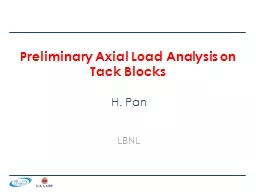

Analysis on Tack Blocks H Pan LBNL Concerns of the Current Tack Blocks Design 9182018 2 The SS shell is linked to the magnet structure only through the tack welding blocks The tack blocks are bolted to the yoke stacks via two M8 SS bolts ID: 813006
Download The PPT/PDF document "Preliminary A xial Load" is the property of its rightful owner. Permission is granted to download and print the materials on this web site for personal, non-commercial use only, and to display it on your personal computer provided you do not modify the materials and that you retain all copyright notices contained in the materials. By downloading content from our website, you accept the terms of this agreement.
Slide1
Preliminary Axial Load Analysis on Tack Blocks
H. Pan
LBNL
Slide2Concerns of the Current Tack Blocks Design 9/18/2018
2
The SS shell is linked to the magnet structure only through the tack welding blocks. The tack blocks are bolted to the yoke stacks via two M8 SS bolts.
Additional axial loads will be imposed on tack blocks and screws due to relative axial movement between the SS vessel and the magnet structure under
different load
conditions:
Room
Temperature pressure test 25 bar
Magnet cooldown
Excitation to the ultimate current
Quench---quench pressure
20 bar
Preliminary analysis shows high stress on the blocks and screws. Axial
compliance is
considered necessary to reduce the additional axial loads.
Slide3FEA Models --- Quadrant Model
9/18/2018
3
SS Shell / Tack Blocks
Bonded
Yoke / Tack Blocks
SS Shell
Tack Block
Slide4ΔUz Between the SS Shell and the Structure
9/18/2018
4
Assuming 0.2
mm welding shrinkage in half SS shell (SS shell barely contacts the structure after cooldown):
Displacements below are from
half length
of the magnet.
Tack blocks are assumed bonded to the structure.
Worst case is in excitation.
Cool-Down
Quench
140 T/m
magnet
SS shell
Center
Initial movement towards magnet center from CD
movement caused by quench pressure
Cool-Down
140 T/m
Quench
Slide5Axial load in Each Screw 9/18/2018
5
Center
End
T5
T1
T2
T3
T4
Allowable stress
The shear stress on screws is much higher than the allowable stress of M8
bolts (
Assuming M8 screw of Class
10.9, equivalent
to SAE Grade 8
).
Slide6If Tack Blocks could Move Axially…9/18/2018
6
The
tack blocks can not constraint the SS vessel to move in the axial direction based on the preliminary results.
If the tack blocks allow the SS vessel to move, the results may become acceptable.
Part
(300K->1.9K)
ΔL (to half
magnet length
) after cooldown
Yoke
2.84E-3
4.6mm
SS vessel
1.97E-3
6.5mm
Relative axial displacement after CD:
~1.9 mm
Relative axial displacement after Powering:
~2
mm
The maximum relative axial displacement takes place in the ends, which is about 2 mm when the magnet was powered to the ultimate current.
Slide7Tack Blocks with Axial Compliance 9/18/2018
7
2 mm displacement
Fixed support
Yoke
Tack Block
Screws
~1 mm
~0.35 mm
Total room of ~ 1 mm to allow block moving axially in the present design, potentially could gain 0.35 mm more.
Slide8Von Mises Stress on Tack Block9/18/2018
8
Von Mises stress (MPa)
block movement ~
1.5 mm
block movement ~
2 mm
block movement
~
1.1
mm
~1 mm
~0.35 mm
There is only 0.35 mm left to make the slot
longer.
redesign
the axial compliance may let us gain enough room to make a longer slot.